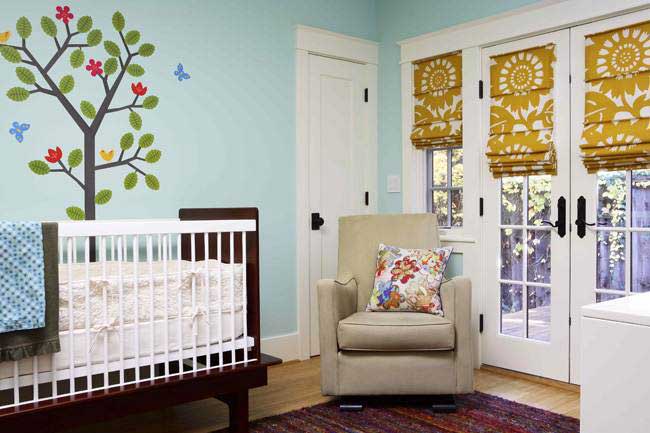Palo Alto Weekly 2011 Winter Home + Garden Design:
Greening an older home
Eco-concerns influence remodel of vintage Palo Alto home
by Susan Golovin / photos by Michele Lee Willson*
Palo Alto Online Staff
Nerija and Jason Titus were pretty satisfied with the 1,300-square-foot, circa 1927 Palo Alto home that they had been living in for six years. "We really didn't want more space," Nerija says.
"University Avenue is an extension of our kitchen, and the playground down the street is our backyard. The city is our home."
However, when Nerija became pregnant they decided to convert a small office into a nursery -- and, while they were at it, deal with improving their heating system and replace the stairway carpets that their indoor cat had ruined.
Nerija says that they knew that the choices they made would be guided by their passion for the environment.
"Jason has been into alternative energy since college," Nerija says. "For me, being green is more of a health issue, but we both wanted a place that would match our aesthetic for responsible living." In this regard they were well served by designer Holly Durocher from Reclaim in Menlo Park, who recommended sustainable products made in the United States (to spare fuel) that were free of toxic chemicals.
"When we ripped up the carpets we discovered that they were over sub-floor, that we would have to replace with new flooring," Jason says. "We wanted to use bamboo, but that wouldn't match the rest of the house."
Ultimately, because they decided to install radiant heating, they replaced the flooring throughout the house. Artistic Tile in San Carlos was their source for recycled ceramic tiles used in the bathrooms and kitchen.
Nerija chose 18-inch square grayish-green recycled kitchen tiles because they matched the existing granite counters and stainless-steel appliances. Woven bamboo flooring from ECO Timber is used in the rest of the house.
"It doesn't show dents because it has a horizontal and vertical grain," Jason says.
"Of course, it makes no sense to put in new heating and not replace the leaky windows," he adds. Since Nerija loved the original divided-light windows, they did their best to replicate them with dual-paned Eagle windows. "We took the old ones to be recycled," she says.
"There was no insulation in the house except for newspapers from the '30s in the attic," Jason says. "We chose to insulate the walls with Airkrete, which is a foam made out of minerals from sea water rather than use a product with polymers that have off-gasses." They replaced the newspapers with blue-jeans insulation, a product that is recyclable and ubiquitous.
"The nursery used to be the kitchen, so it even had stove vents," Nerija says. The access to the room was improved by eliminating two doors and creating a wider hallway, which is framed on one side by a wrap-around bookcase. In order to provide enough light once the doors to the room became solid walls they enlarged the nursery windows and added a skylight.
All of the paint inside and out is no-VOC (no toxic chemicals) from Yolo Color House in Portland, Oreg. "Nerija really wanted to choose paint colors for the nursery that are not baby-ish," Durocher says. Such longterm thinking also informs the choice of an Argington convertible crib. "We try not to buy stuff that will be useless when he's 3," Jason says.
The living room furniture is from EKLA as well as Urban Woods. "They use nontoxic finishes and wood from environmentally sound sources, Durocher says. "The fabrics are not treated with chemicals, and the cushions are made from natural rubber rather than plastic foam. ... There is a limited selection of green furniture, but these places do custom work."
The Toto dual-flush toilets spare water, low-voltage lighting uses less energy and individual heat registers allow for heating only those areas in use. Jason says the photovoltaic (PV) panels on the roof already generate 15 to 20 percent more power (electricity) than they use.
What's next? "I'd like to put solar panels on the roof. We could store pre-heated water (for domestic use as well as to heat the floors) in the basement and substantially cut our gas usage," he says.
Resources:
Architect: Jennifer Lee, bayareadesign@comcast.net
General contractor: Bill Fry, Wm. H. Fry Construction Co, www.billfryconstruction.com, 408-605-8200
Interior designer: Holly Durocher, Reclaim, Menlo Park, www.reclaimhome.com
Design challenge: Remodel in as ecologically prudent way as possible
Unanticipated issues: Entire plumbing system needed to be replaced due to sewage leaks and mismatched piping
Year house built:1927
Size of home/lot:About 1,350-sq-ft home on a nonconforming 3,000-sq-ft lot
Time to complete:About a year
*Photos courtesy of Reclaim; photography by Michele Lee Willson, styling by Laura Del Fava
 |
Eco-friendly materials range from the woven bamboo flooring by ECO Timber to the dual-paned Eagle windows, with living room furniture by EKLA and Urban Woods. Photo courtesy of Reclaim; photography by Michele Lee Willson, styling by Laura Del Fava. |

Choices for the new nursery included non-babyish colors (in no-VOC paint) and a crib that will convert into a child's bed. Photo courtesy of Reclaim; photography by Michele Lee Willson, styling by Laura Del Fava.

Plumbing in the bathroom and kitchen had to be replaced due to sewage leaks and mismatched piping. Recycled ceramic tiles are from Artistic Tile in San Carlos. Photo courtesy of Reclaim; photography by Michele Lee Willson, styling by Laura Del Fava. The bathroom leaf-and-vine motif carries over from the tile to the toilet-paper holder. Photo courtesy of Reclaim; photography by Michele Lee Willson, styling by Laura Del Fava.